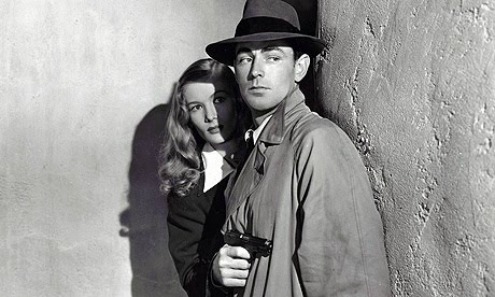
Film noir is best described as a time and place in American cinema – where filmmakers were becoming increasingly cynical and disillusioned with American life due to many things: the war, the depression (which just ended), and maybe a little bit because of constraints many filmmakers were forced to adhere to in order to make a Hollywood film. As Paul Schrader says, “film noir is not a genre.” Instead it’s more a style defined by shadowy lighting, sleazy locations, and themes of isolation, alienation, and pessimism. The most important thing to remember about film noir was that its creation wasn’t intentional – especially by the studios. But by the time anyone realized what was happening – it was too late to stop the surge of noirs that would dominate the mid-40s and the mid-50s.
One of the most important films in the development of film noirs was Paramount’s This Gun for Hire – it also has a lot of plot. This Gun for Hire follows Phillip Raven, played by Alan Ladd, a hitman on a mission to kill his former employer after being framed for a robbery he didn’t commit. On the way he meets Veronica Lake’s Ellen Graham – a singing magician working as a spy for a Senator who’s trying to expose a traitorous weapons manufacturer selling weapons to the enemy. When Raven and Ellen cross paths she convinces him to help her expose the weapons manufacturer, telling him, “This war is everybody’s business. Yours too.”

But what makes this film an important noir is Alan Ladd’s performance as the sinister Raven – who, at the beginning of the film, rips a woman’s dress and slaps her, kills a couple in cold blood for money, and ends the film almost as a martyred hero. As he begins to form a relationship with Ellen, Raven becomes her protector and ultimately dies for her and her cause. A decade earlier – this might have seemed unimaginable, but in 1942, audiences were ready to welcome such complexity that wasn’t before portrayed on screen. The film’s actual hero, Ellen’s fiancé cop played by Robert Preston, is as memorable and entertaining as watching a fly die.
In This Gun for Hire Ladd plays what might be the first hitman turned anti-hero – launching Ladd into stardom and starting a series of films starring Ladd and Lake together. But This Gun for Hire is too goofy at times, with cartoonish villains and two very boring Veronica Lake musical sequences. No, the development of what would be known as film noir would be complete with another Paramount film.

Double Indemnity would perfect so many tropes that have become synonymous with the “not-genre” of film noir: flashback narration, a cynical protagonist, and the femme fatale to end all femme fatales in Barbara Stanwyck. In the film, Fred MacMurray stars as Walter Neff, an insurance salesman who falls in love with Stanwyck’s Phyliss Dietrichson. Together, they plan to kill Phyliss’s husband and make it look like an accident, so they’ll inherit the money they’ll gain from the insurance claim. MacMurray and Stanwyck’s complicated chemistry and their quick descent into corruption, greed, sex, and temptation felt – and still feels to this day – deliciously compelling. Never before have audiences root so hard for two killers – by the time the duo actually begin to commit murder, you’re hoping they get rid of Phyliss’ lame and boorish husband without a hitch. But of course no murder is perfect.
Double Indemnity was a huge success – and a thousand copycats (some masterpieces in their own right) would soon follow. By 1946, the film noir trend surged with films like The Blue Dahlia, The Postman Always Ring Twice, The Killers, Humoresque, and Gilda all being released in the same year.
This Gun for Hire and Double Indemnity – highlights the elements of noir that have remained universal to this day. From Raven’s feelings of isolation and loneliness to Neff and Phyliss’ disillusionment of their current lives and their desire for more. There’s something about these films that still ring true and why their basic premises have become almost cliche.
 Tatiana Nunez is an English major on the Writing and Rhetoric Track and is in her Senior Year at FIU. Her favorite films include The Handmaiden and Heat. And her go-to genres are horror, action, and erotic thrillers.
Tatiana Nunez is an English major on the Writing and Rhetoric Track and is in her Senior Year at FIU. Her favorite films include The Handmaiden and Heat. And her go-to genres are horror, action, and erotic thrillers.
